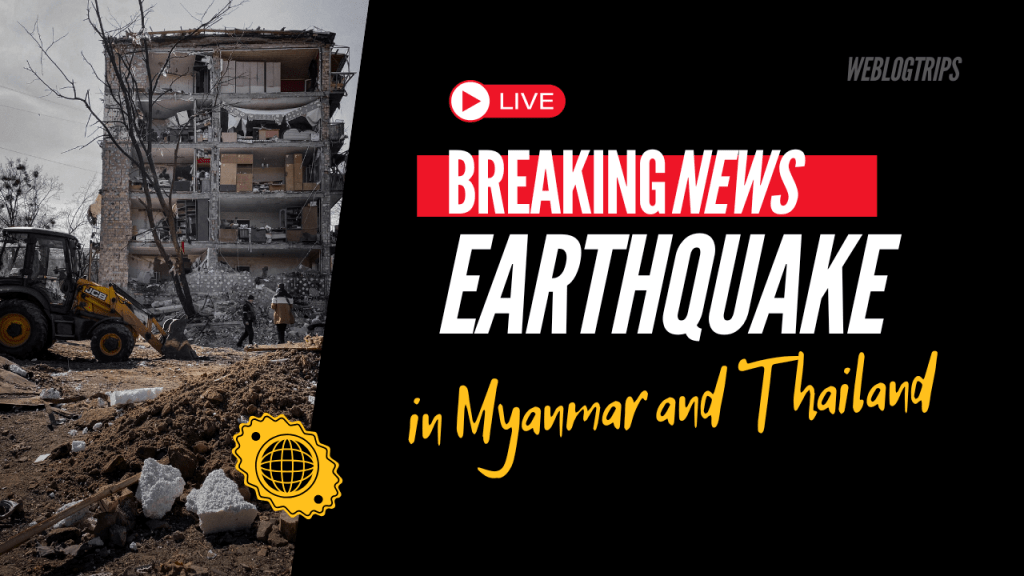On Friday, a powerful 7.7 magnitude earthquake struck Myanmar, sending shockwaves across the region. As a result, neighboring Thailand also felt the devastating effects, prompting authorities to declare a state of emergency in both countries. This tragic event has raised concerns about the region’s preparedness for natural disasters and the challenges that lie ahead for recovery.
Myanmar Earthquake: A Nation in Crisis
The earthquake’s epicenter was near Sagaing, close to Mandalay. The tremors caused widespread damage in the region. For example, the 90-year-old bridge in Sagaing collapsed, and part of the former royal palace in Mandalay was destroyed. Additionally, sections of the highway connecting Mandalay to Yangon suffered severe damage, which complicated rescue and recovery efforts.
In response, Myanmar’s military-run government declared a state of emergency in six regions and states, including those most affected by the earthquake. While no immediate casualties have been reported, many regions remain difficult to access due to ongoing conflict and poor infrastructure. This disaster comes at a time when Myanmar is already dealing with instability following the 2021 military coup, which further hampers the government’s ability to provide timely assistance.
Thailand’s Response: Tragedy in Bangkok
Meanwhile, as the tremors rocked Myanmar, Thailand faced its own crisis. Bangkok, the capital, experienced the collapse of a 30-story building in the Chatuchak Park area, which trapped 43 construction workers inside. Unfortunately, two workers died, and seven survivors were rescued from the rubble.
The collapse of the building, which housed 50 workers, sent a cloud of dust into the air. A video circulating on social media captured the tragic moment as onlookers screamed and ran for cover. Consequently, Thai authorities quickly declared a state of emergency in response to the destruction, with emergency teams rushing to the site to assist in rescue efforts.
Aftershocks and Ongoing Damage
Just 12 minutes after the initial tremor, a second 6.4 magnitude quake struck the same region, intensifying the crisis. The aftershocks triggered more panic across Bangkok, where alarms went off in high-rise buildings. As a result, thousands of residents fled to the streets for safety. Many people in the city’s high-rises reported water sloshing out of pools as the ground shook, underscoring the power of the tremors.
The earthquake affected more than 17 million people in the greater Bangkok area, many of whom live in tall apartment buildings. In the aftermath, authorities are working to assess the full extent of the damage while coordinating efforts to rescue survivors and clear debris.
The Role of the USGS and Future Preparedness
The US Geological Survey (USGS) reported that the earthquake was shallow, with a depth of only 10 kilometers, which likely intensified the tremors. Experts continue to monitor the situation closely. Additionally, the region’s proximity to tectonic plate boundaries makes it highly vulnerable to future seismic activity. Authorities expect aftershocks to continue in the coming days, which could pose additional risks to already weakened structures.
Given these circumstances, both Myanmar and Thailand face the significant challenge of providing aid to affected populations. However, emergency responders, local volunteers, and governments are working together to locate survivors, clear debris, and restore basic services. This crisis also highlights the urgent need for stronger building infrastructure in regions prone to earthquakes and the importance of preparing for future disasters.
Conclusion: A Region on Edge
The recent earthquake in Myanmar and Thailand serves as a stark reminder of the unpredictable power of nature. It also brings attention to the vulnerabilities of regions located near tectonic plate boundaries. While the initial tremors have subsided, the recovery efforts will continue for months, if not longer. In the meantime, authorities must remain vigilant and prepared for any further aftershocks.
For residents, staying informed and being prepared for possible future tremors is crucial. This disaster also underscores the need for Southeast Asia to strengthen its infrastructure and disaster response strategies. Ultimately, by learning from this event, countries in the region can better protect their citizens and minimize the impact of future earthquakes.
Stay informed with Bangkok News and Euronews for ongoing updates on the situation.
About Us
- Akhil Boddu’s YouTube Channel – Follow my vlogs for personal experiences and tips.
- Code With Me YouTube Channel – Explore tech tutorials and coding advice.
- Weblog Trips LinkedIn – Connect with me on LinkedIn for more insights and discussions.
If the information you are looking for is not available here, please contact us. Additionally, follow us on our social media platforms for updates and more information.







